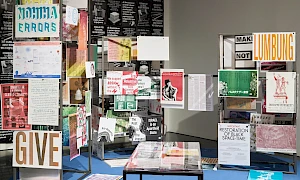Towards Collective Learning, or, Decompartmentalizing Education
In this conversation colleagues from L’Internationale reflect on education and learning within institutional spaces. Considering the changing place of education in the artistic context, from the 1970s to today, and drawing on diverse exhibition and publishing practices, the discussion foregrounds the need for, and the potential of, intergenerational, trans-disciplinary learning.
Nick Aikens (NA): I am interested in the L’Internationale Online platform, and the confederation more broadly, as a space to do collective work that can’t be done within the individual partner institutions. The idea for this discussion came out of the first editorial board meeting of L’Internationale’s current four-year programme, ‘Museum of the Commons’, in Gothenburg last year, which focused on ‘Situated Organizations’, one of the programme’s three content strands. The three of you began talking about education within institutions, and the need to evaluate and rethink how it is positioned. Specifically, the compartmentalization of educational work came up, or how education might be decompartmentalized.
Fran MM Cabeza de Vaca (FV): Perhaps this will be the first of a series of conversations with members of the editorial board addressing areas of interest that will be on the table for the next few years. To begin with education feels like a significant statement.
María Berríos (MB): It is generative to talk in a trans-institutional context. I’m pleased we are starting with education, and with what education is and could be in a museum context.
NA: Fran, you are part of the educational department at the Museo Nacional Centro de Arte Reina Sofía (MNCARS, Madrid); Yolande, you work on exhibitions at the Van Abbemuseum (Eindhoven); and Maria, you are Director of Curatorial Programmes and Research at the Museu d'Art Contemporani de Barcelona (MACBA). As a starting point, could we speak to the idea of (de)compartmentalization from your respective positions? Maria, I think you introduced the term?
MB: Sure. To start with, there is still a general conception that education exclusively deals with schools, children, young people. This is strange when we consider how art and education are closely linked and the so-called educational turn of the mid-1990s.1 This ‘turn’ enriched discourse around art practices, yet the discourse around education itself remains largely unchallenged. Everyone assumes that art is linked with education and that art can be educational, but within arts organizations, the recognition of artist-educators has been a long struggle. This became clear to me during the Berlin Biennale I worked on in 2020. We collaborated with a lot of artist-educators and a pattern began to emerge: in different ways, their practices were systematically split between these two supposed ‘roles’ – not out of choice but because art institutions demand that they have a mediation portfolio that is distinct from their artistic portfolio, as if these dimensions were not part of an integral artistic practice. In addition, the uphill struggle to have the ‘educational’ aspect recognized had an economic subtext: educational and mediation work is often considered ‘lesser’ and paid worse, so there was another agenda behind pushing that part of their work into an artistic category.
One way to rethink education and its role in institutions is to approach it intergenerationally, which began back in the 1970s. Then, there was at least some reflection and effort made in and by western institutions to have children, parents, sometimes also grandparents, in the same space, inhabiting art venues with free play, or enabling women to hold academic discussions by providing childcare. Of course, there are many critiques of these situations: the fetishization of childhood as inherently experimental, making a spectacle of children’s play (Palle Nielsen in 19682); or images of progressive academic men taking care of children as an extraordinary act instead of a normal part of human collective life – for example, Stuart Hall photographed with a child in the crèche of the ‘Women’s Liberation Conference’.3 There were (and still are) more informal spaces, often migrant spaces or non-white, non-hegemonic spaces, where kids hanging out at adult cultural gatherings was a given – there was no choice and no one bothered too much about the children sleeping on the couch or playing under the table late into the night. For the global majority, intergenerational spaces are part of everyday life, while adultism and ageism are western phenomena, specific to contemporary academic and cultural institutions.
Still, there is no need to romanticize the past or the world outside the tiny bubble of contemporary art to acknowledge that we have not exactly progressed in this learning curve. Now, the best we can hope for within the spaces of contemporary art is more-or-less sophisticated versions of neoliberal services where children can be entertained, while we adults engage in this more emancipatory knowledge-sharing we call ‘art’, whose transformative potential we supposedly believe in, while we invest very little energy (or budget) in making it relevant to those we deem either not old enough or too old – to anyone other than an able-bodied art-loving adult. I’m drawing a caricature, and as a mother I am always grateful for the amount of times (that I can count on one hand) I was able to leave my child in some form of reliable care in order to be able to see an exhibition or attend a seminar. But the fact that this already feels like a big deal is a little depressing. We need to be able to imagine some kind of mutual contamination beyond demarcated spaces that have become more and more compartmentalized, and find ways to co-inhabit, some mutual intergenerational exposure capable of collapsing this divide. I know there are many people who have been working hard in this direction for some time, but it is also important to acknowledge that the resources to work intergenerationally and transversally are scarce, difficult and always the first to be cut or erased. These are some of the issues that are relevant for us to address and that we moved through when we last met.
NA: Listening to you, Maria, I recall the ground floor of the Fridericianum in documenta fifteen, which was dedicated to educational and daycare spaces. What I found compelling about that building was that education or learning was part of a curatorial strategy that unfolded as you moved up the floors of the building. The ground floor was given over to education and daycare, the first floor was occupied by archives and history-making, and then on the top floor there was a more diverse range of collective practices around care and solidarity. There was a clear choreography based around education that was carried through the building.

documenta fifteen: Gudskul, Fridskul, 2022, Fridericianum, Kassel, 14 June 2022. Photo: Nicolas Wefers
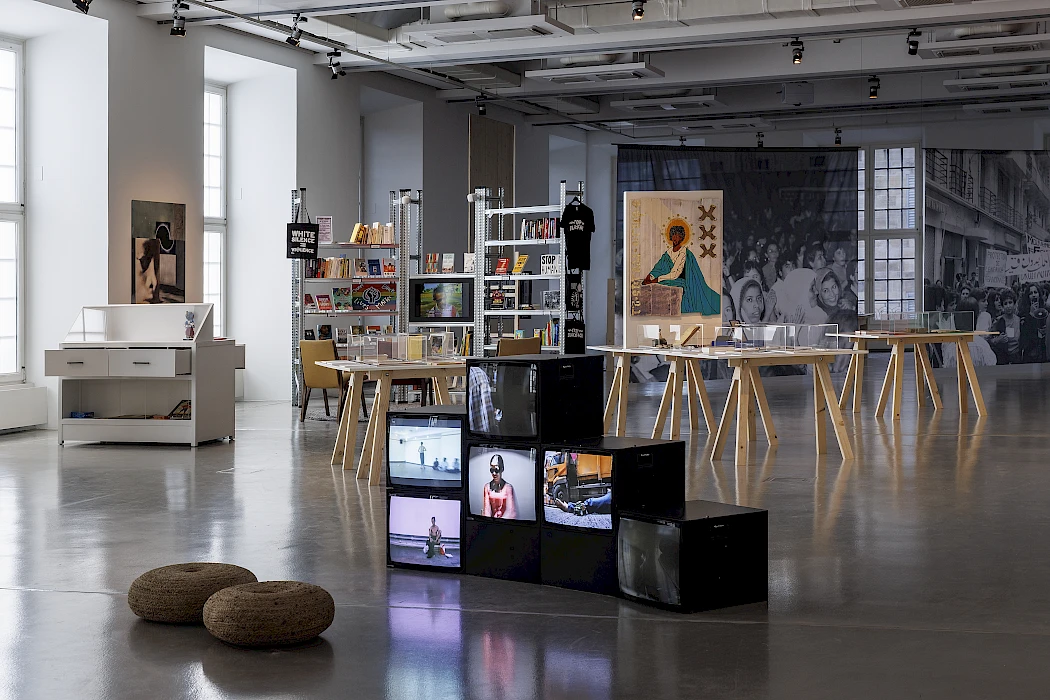
documenta fifteen: Asia Art Archive, 2022, The Black Archives, 2022, Installationsan shot, Fridericianum, Kassel, 11 June 2022. Photo: Frank Sperling
FV: I read an interview with Susanne Hesse-Badibanga, who was the head of the education department of documenta fifteen, where she talks about the education programme being a failure.4 The proposition of lumbung encompassed education but in a totally disseminated, integrated way. Yet the education department still felt the need to do guided tours, where visitors could ask what the ‘meaning’ of a certain work is, even though that was counter to the curatorial proposal, built around collective working methods, friendship paradigms, and so on, which radically alters traditional notions of education and mediation. Within the idea of ‘expanded education’, the proposition is that it can happen anywhere, anytime.5 I feel this is a useful case study to see what happens when you really vacate the space of education, both physically and conceptually, because it is already somewhere else, within the social processes of the practices. It’s also a good example of how collective practices can address the limits of compartmentalization.
Yolande Zola Zoli van der Heide (YH): Yes, it was all built within the structure that ruangrupa put forward. I’m thinking specifically of the free daycare that artist Graziela Kunsch offered in the Fridericianum.6 I met Graziela at Casco Art Institute in Utrecht, where I worked before the Van Abbemuseum, in the context of the action research project ‘The Grand Domestic Revolution’, for which she focused on another form of invisible labour – cleaning as an act of habitation. In her words: ‘To work with domestic (or public) space is not necessarily a matter of what we put in the space, but … how it can be created and recreated’.7
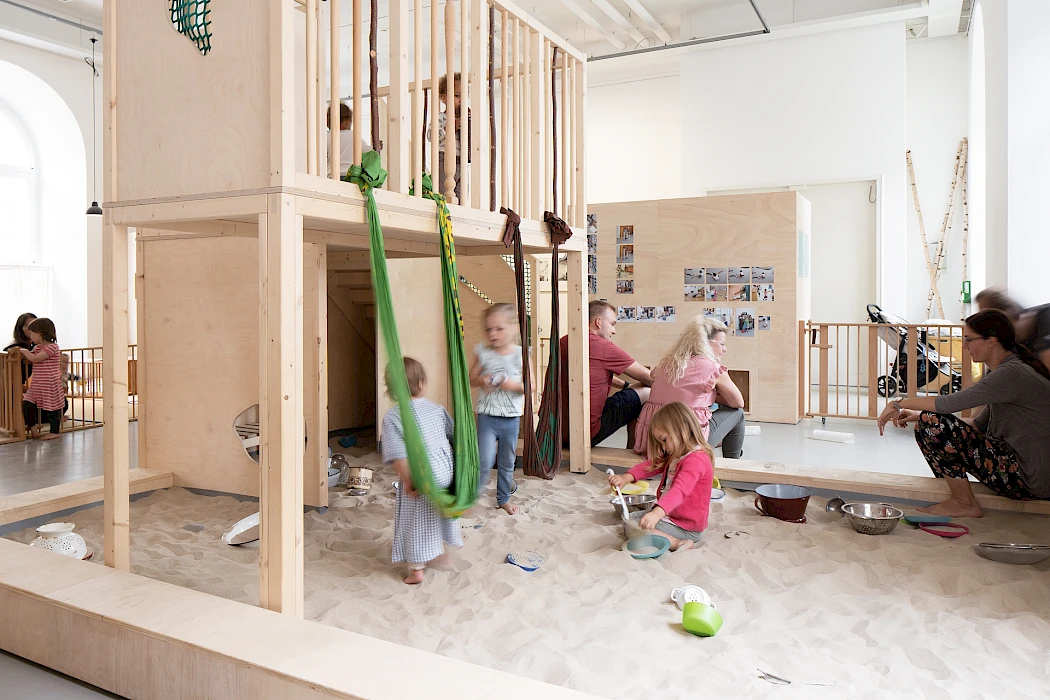
documenta fifteen: Graziela Kunsch, Public Daycare, Fridercianum, Kassel, 2 September 2022. Photo: Nicolas Wefers
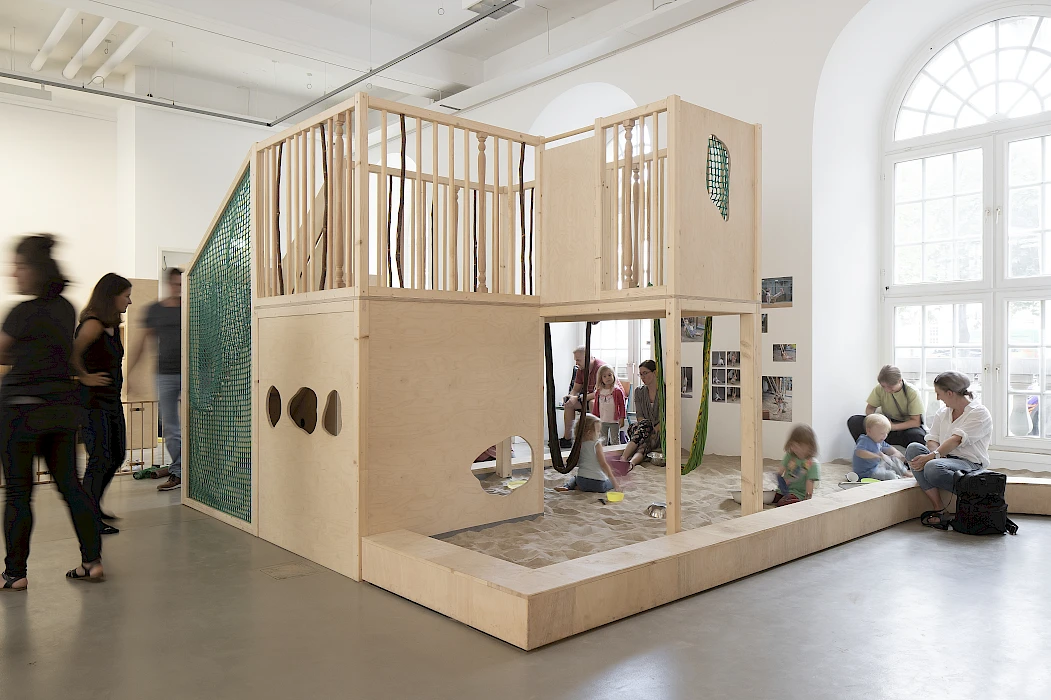
documenta fifteen: Graziela Kunsch, Public Daycare, Fridercianum, Kassel, 2 September 2022. Photo: Nicolas Wefers
Graziela’s Public Daycare at documenta connected to local centres. It’s also significant that it was on the ground floor, near the place of entry, which is usually reserved for prescribing what the exhibition is ‘about’ to the public, through wall text, for example. Instead, there was this daycare that centred how children aged 0–3 learn with their parents, as if to signal that the rest of the exhibition might require a similar degree of curiosity, openness and beginner’s mind. This is then developed in the exhibition through the lens of archival and collective practices, but always with a connection back to that ground floor and the premise of learning together.
We are thinking here about the scope, potential and limits of institutions precisely because documenta fifteen shifted this question through collective practice. Fran mentioned that education departments are often taken for granted or are the first to be cut when an institution downsizes. Yet exhibition mediation is a potential zone where institutional transformation can take place, if we understand that mediation is not so much about describing or explaining artworks, and more a place to begin to enact what they can do.
To give an example, the project A Lasting Truth Is Change (ALTIC) at the Van Abbemuseum (2022) brought works from the museum’s collection into conversation with works from outside it to ask how heritage institutions (those that preserve and display content of ‘historical value’) can move into a sound relation with change.8 The exhibition’s framing proposed other ways of viewing a museum’s collection away from the usual approach of telling a story of the art through chronology or geography, for example. Perceiving works through the lens of different subjectivities and bodies, particularly children, was something we foregrounded. The entrance gallery was titled ‘Beginner’s Curiosity’, and we hung works at the average eye level of children between six and twelve years old living in the Netherlands, rather than the standard 150–160m hang height, so inviting the rest of the public to adapt their bodies away from normativity. Another way we tried to engage with the public intergenerationally was through an activity book with ‘children’s exercises’ informed by some of the questions the artworks invite reflection on.
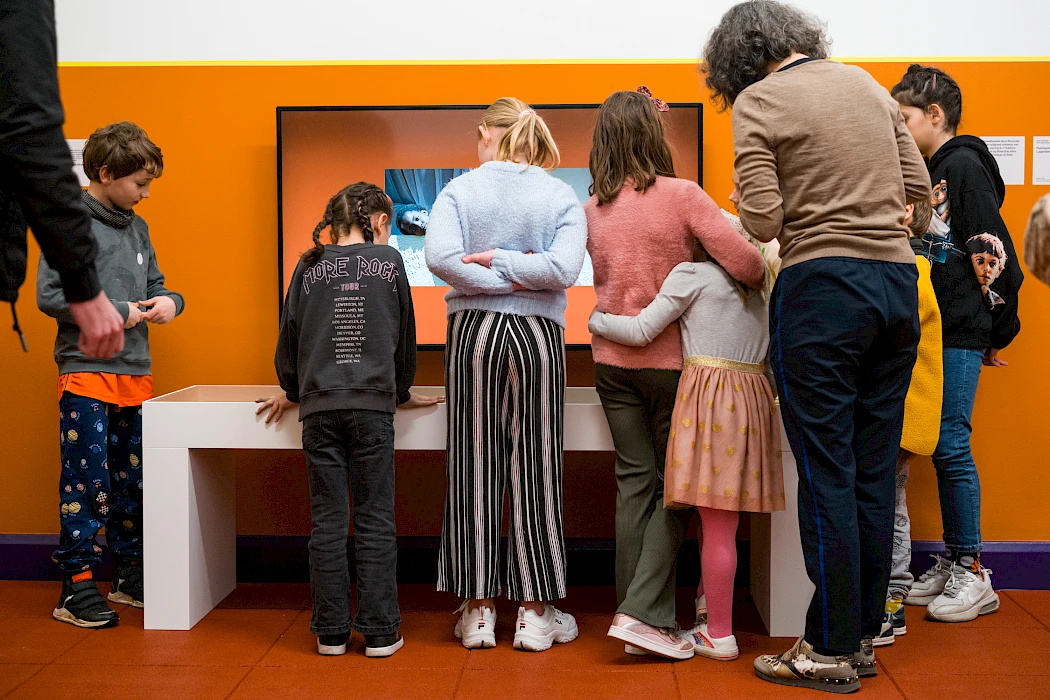
Visitors at A Lasting Truth is Change, Van Abbemuseum, Eindhoven, The Netherlands, 2022. Photo: Boudewijn Bollmann
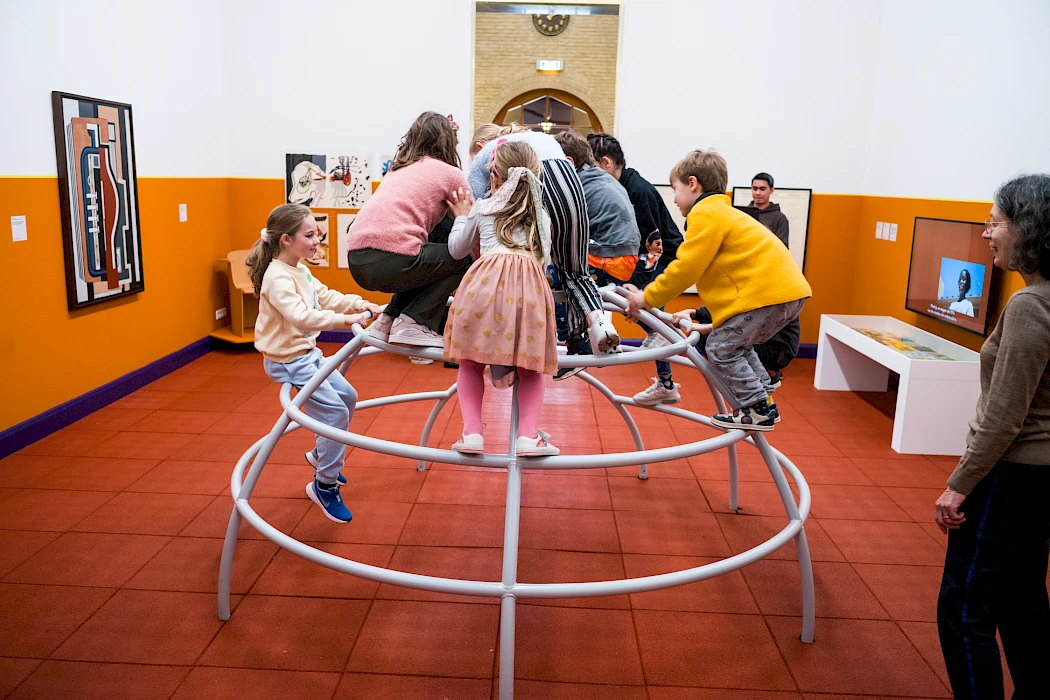
View of A Lasting Truth is Change, Van Abbemuseum, Eindhoven, The Netherlands, 2022. Photo: Peter Cox
FV: The term ‘education department’ gives the impression it is the only place through which teaching happens. Yet the museum is educating all the time. Every single department, every single institutional decision contributes to education. Security, the guards who stand throughout the building, is education; the blockbuster exhibition is education; political film is education. Why don’t we acknowledge that the whole institution is educating? In documenta fifteen everything melted together, because education was taken away from a specific department – it was decompartmentalized, to use Maria’s term.
MB: This is what happens when education is acknowledged as part of everything: all cultural institutions, for better or worse, are an extended learning community. Yet all of these shifts in understanding come with infrastructural implications. If we don’t need education anymore because it’s ‘everywhere’, then, through some strange vampiric algorithm, this is used as an argument for the education department to suffer further cuts. Graziela Kunsch’s crèche was not actually a crèche, because you had to be there with the kids, they could not be left. That is an interesting difference because it’s not there to enable the adult part of the artistic experience. The problem with compartmentalization is that it’s the act of making an infrastructure, of creating a space that competes with another space, and in the end it essentially comes down to a power game between what is deemed more important. I would love for you to talk more, Yolande, about the actions of shifting exhibition norms, like hanging differently, and how you came about mediating this through a children’s book.
YH: ALTIC was developed in the height of the pandemic; I began working at the Van Abbe in 2020. Also at a time when many of us were faced with just how short our places of work fell from the politics they laid claim to, the disparity between their frontends and their institutional backends, so to speak. So, the question of institutional change was in the zeitgeist. The overwhelming response from museums to the question of ‘how to be in better relation with one’s immediate community’ was to work with what there is at hand – the collection. I eventually began working with the Van Abbe’s collection with this sentiment in mind, while rubbing up against institutional norms and thinking through institutional reform. The collection is how you can size up institutional values, through what has been acquired over time, while temporary exhibitions are more representational, they showcase a practice or a set of politics that the institution is operationally divorced from.
To speak concretely: out of the Van Abbe’s relatively small collection of around 3,200 works, there are 150 by female-identifying artists. One knows these things abstractly but it is something else to find them out materially and have to deal with it. I’m citing this figure to share the types of violences and normativities you are faced with behind the representational wall. But I was not interested in waving my finger at the museum, a job always tasked to people who look like me. I was interested in having fun with the problem, and wanted to think through how change could figure into an institution. I leant into Octavia E. Butler and her unfinished Parable series (1993–98), which follows a teenager, Lauren Olamina, who is preparing for and manages to organize her community around change in the face of the apocalypse. Teens and learning are at the centre of the second novel, Parable of the Talents. As I was interested in talking about the museum’s collection through questions of change, I grouped works in relation to one another and in dialogue with lessons that arose from Butler’s work: ‘Prayer’, ‘Connectedness over Autonomy’, ‘Resistance and Self-Determination’, ‘For Us to Get Grounded’, and ‘Death’, to name a few of the gallery themes. A mediation book aimed at children was a way to represent these ideas clearly and to challenge myself to land things practically, as it called me to refrain from abstraction or abolitionist discourse. We developed an activity book with small assignments for each gallery around how the works were arranged and what they may invite us to do or think of as viewers.

Views of A Lasting Truth is Change, Van Abbemuseum, Eindhoven, The Netherlands, 2022. Photo: Peter Cox
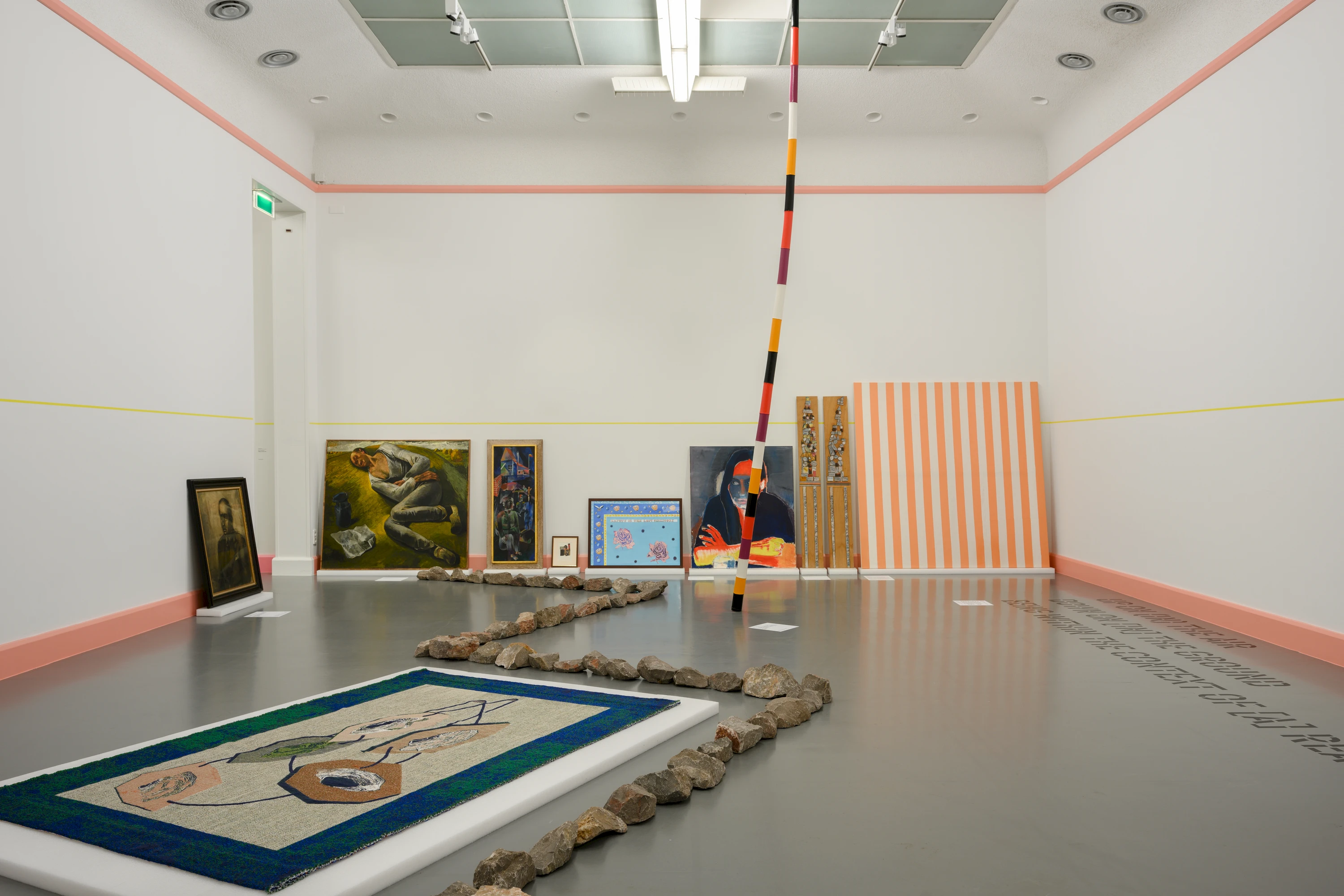
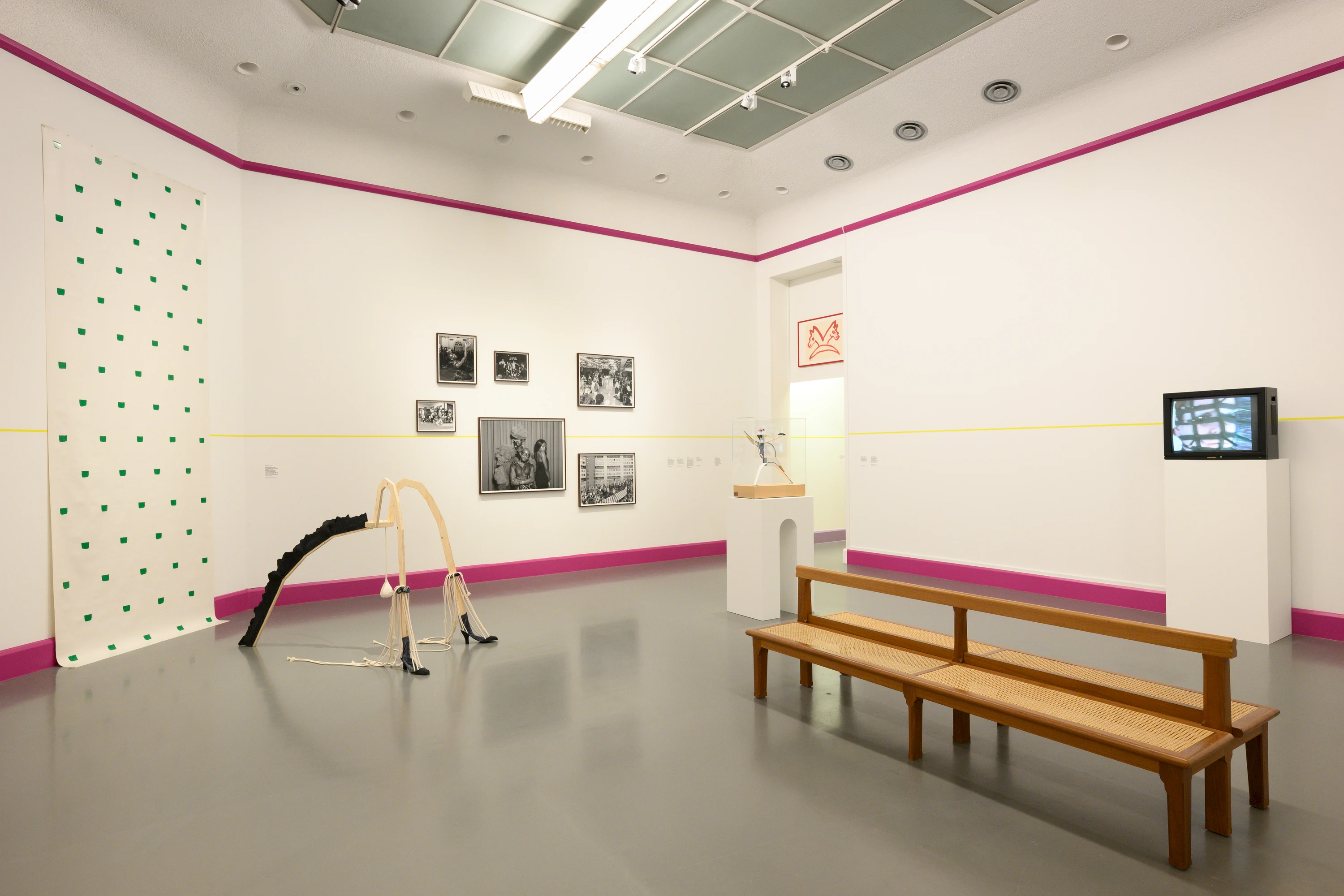
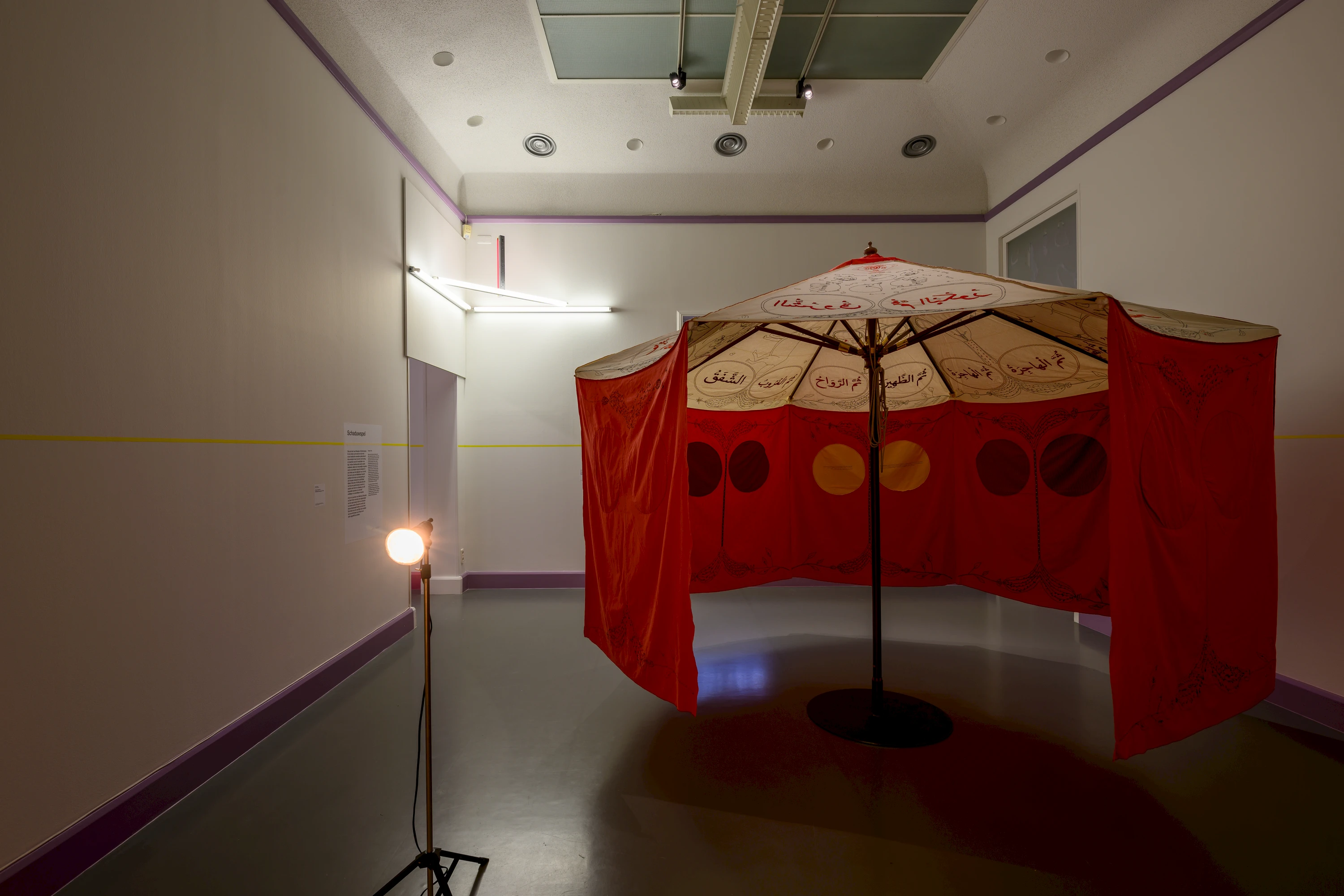
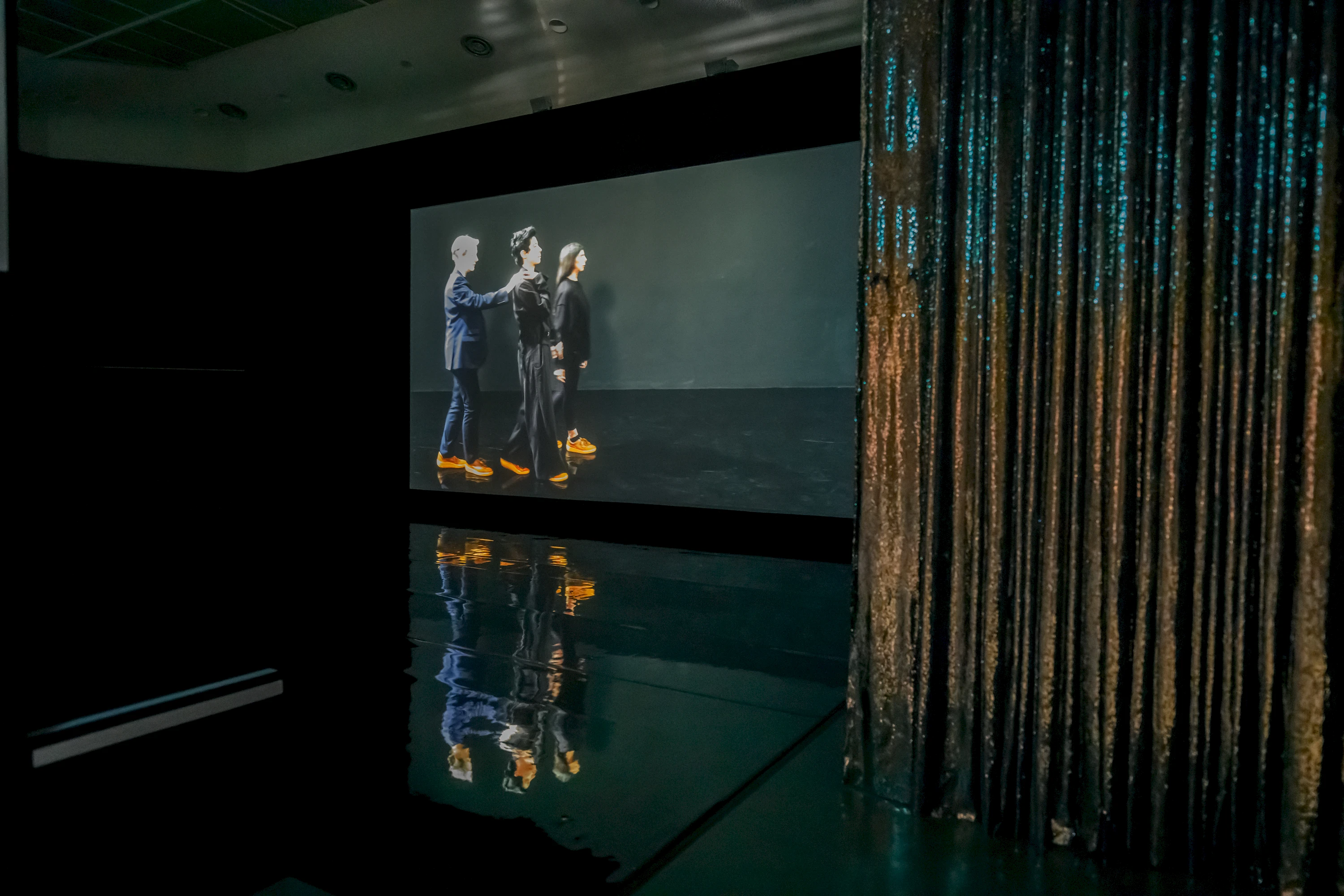
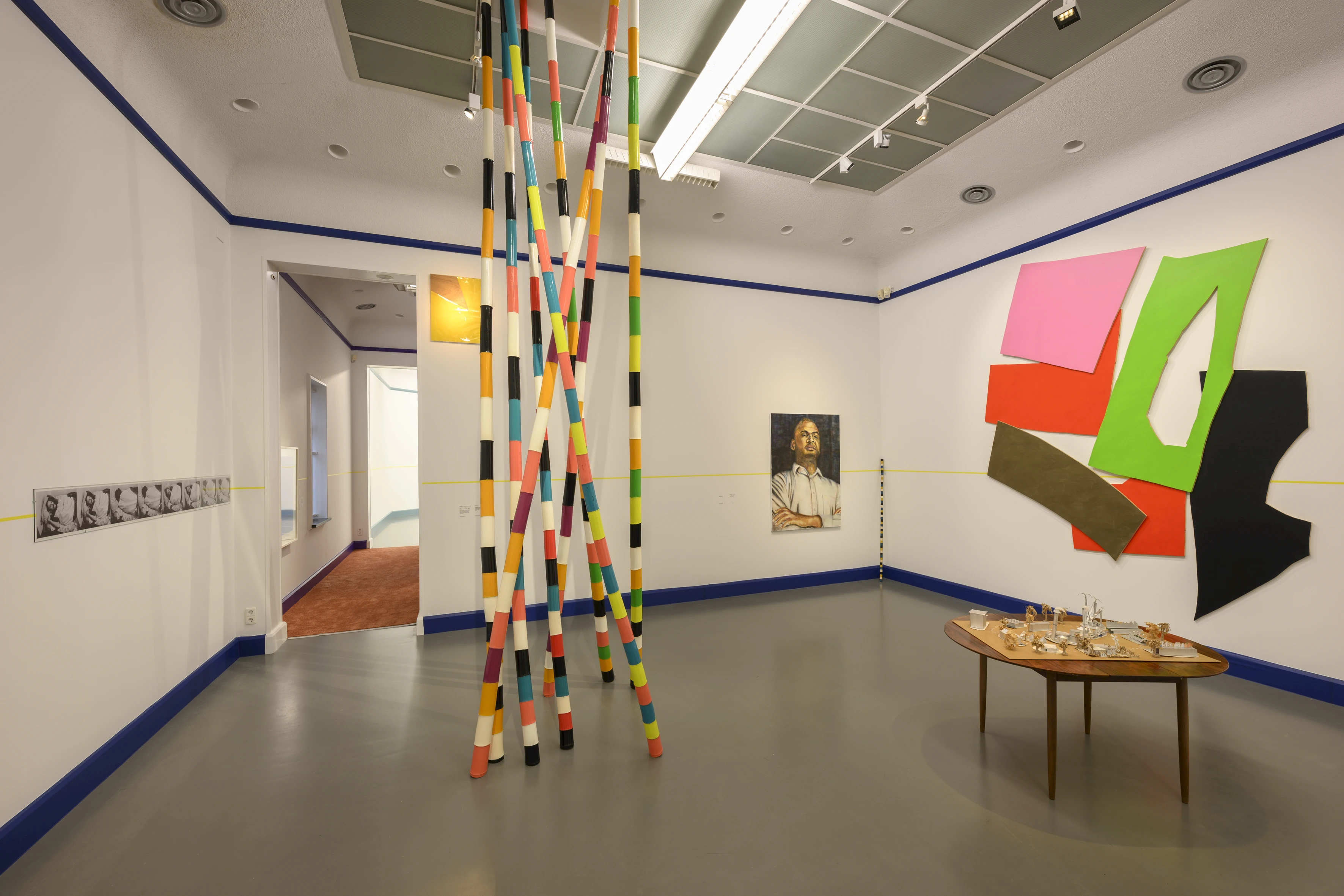
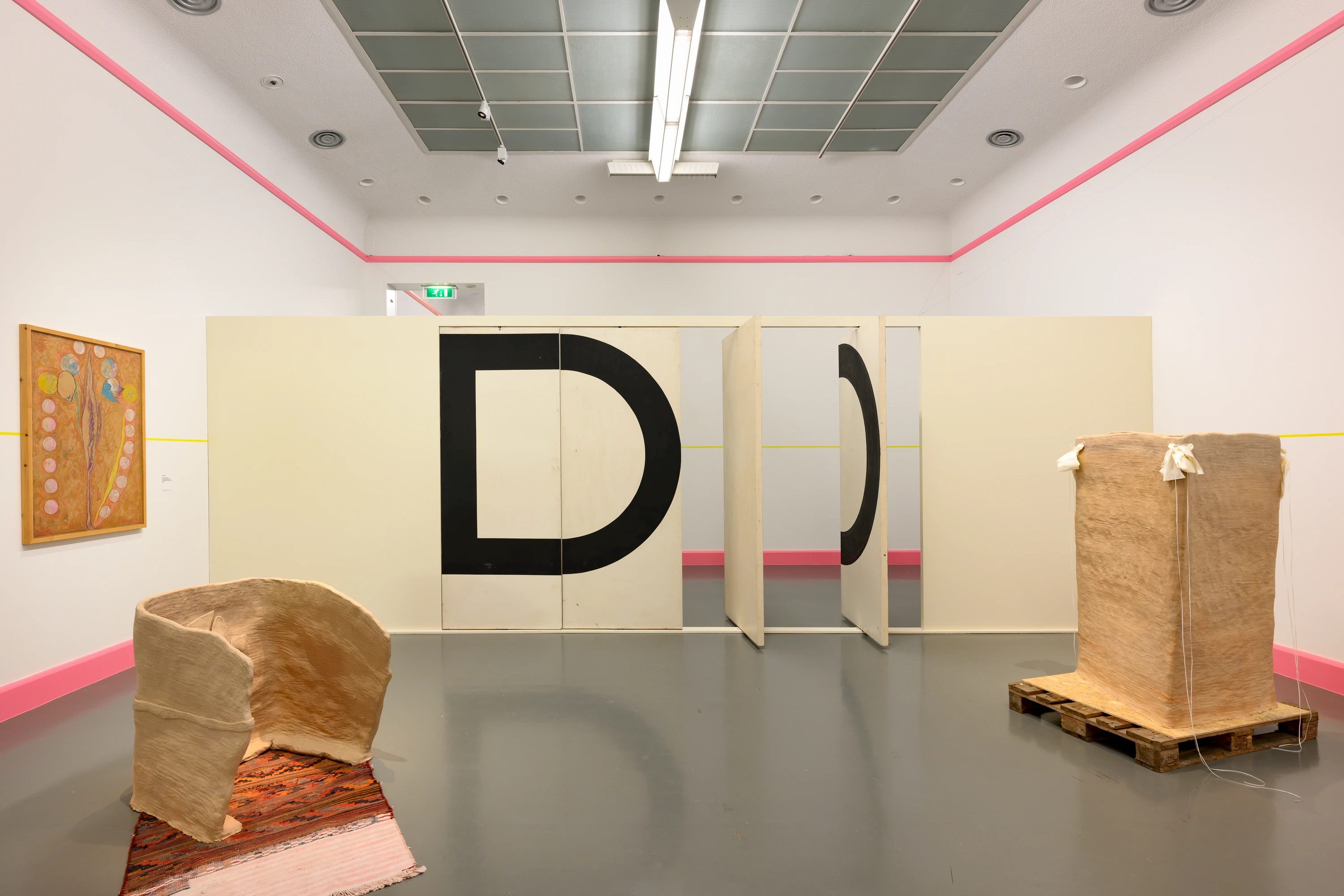
MB: Last time we spoke we exchanged on our experiences of working with picture books as a part of exhibitions as a way of working across generations and using a language that is not dependent on the rational-discursive to connect or mediate things. It is indeed a relevant way of ‘grounding’ or creating concrete forms of exchange and encounter. The project ‘En la selva hay mucho por hacer’ (‘In the Jungle There Is Much to Do’, 2022–239) was linked to the collection of the Museo de la Solidaridad Salvador Allende (MSSA, Museum of Solidarity) in Santiago, Chile, and to the picture book of the same title [published by the anarchist commune Comunidad del Sur in Uruguay in 1971].10 I proposed to the museum team that I collaborated with to use that particular picture book, which has an important role in tying together communities of solidarity and exile in the 1970s and 1980s, as a compass and a way of entering certain stories inhabiting the collection. The first question we asked was: what works have never or very rarely been shown? And the results were amazing – also in the case of the museum’s specific history, most of the rarely exhibited pieces were works on paper by women, exiled artists, and the few black and indigenous artists in the collection.

View of the exhibition In the Jungle There Is Much to Do. Courtesy of MSSA. Photo: Benjamín Matte
We used picture books to connect to the idea of a popular library. We could consider a conventional museum collection as a kind of academic or reference library where all knowledge around a specific history – that of the museum as an institution – is stored. The community or popular library is a very different proposition; what is there is there because it is of use, and it is formed by the community out of interest. The book In the Jungle There Is Much to Do is an anarchist fabulation of political prison. Apart from the fact that many of the works in the collection, due to its unique history,11 were actually made by political prisoners and told stories of political prison and exile, we also used it to reflect on the collection itself: the rarely exhibited works had until that moment been mostly constrained to the vaults of the museum so they could themselves be considered political prisoners – particularly coming from a museum that was conceived to be shown in factories, schools and in the streets. We used In the Jungle… and other picture books as entry points to the history of the Solidarity Museum, which in itself became a kind of fable.12 Within this framework, the whole museum was turned into a community library you could sit down in.
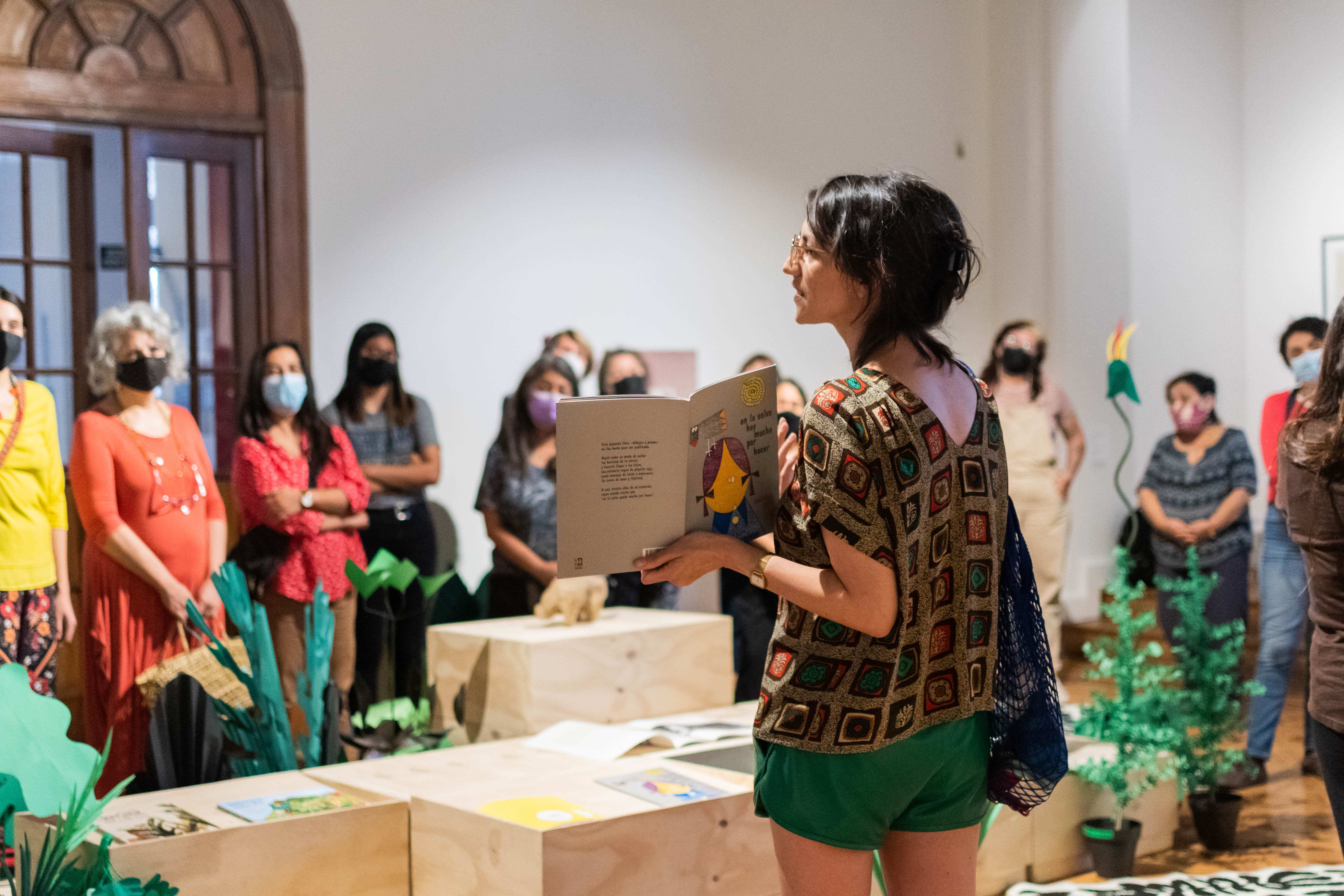
Collective reading of Mauricio Gatti’s In the Jungle There Is Much to Do. Courtesy of MSSA. Photo: Lorna Remmele
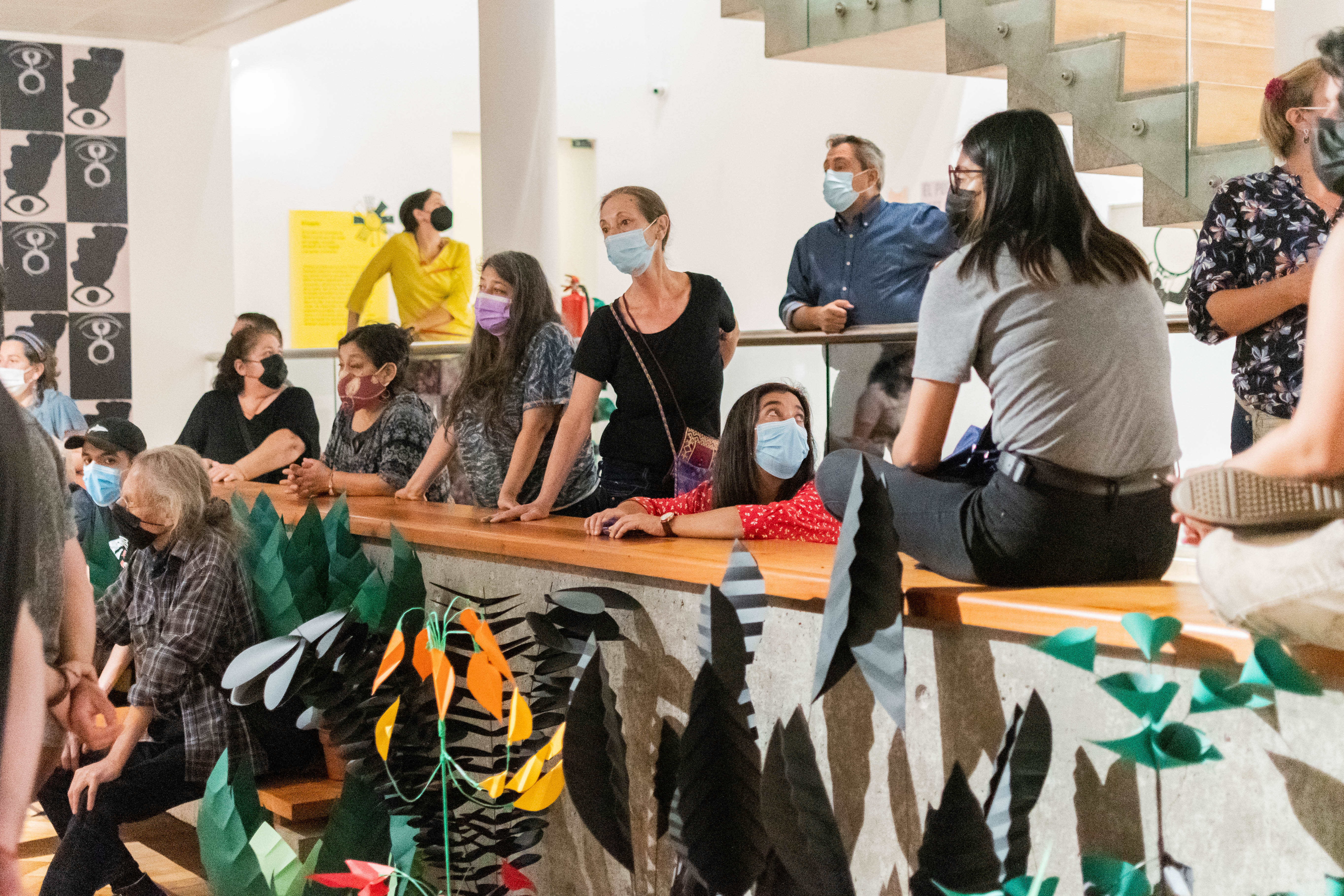
Visitors of collective reading in ‘The Little Fire’ section of the exhibition In the Jungle There Is Much to Do. Courtesy of MSSA. Photo: Lorna Remmele
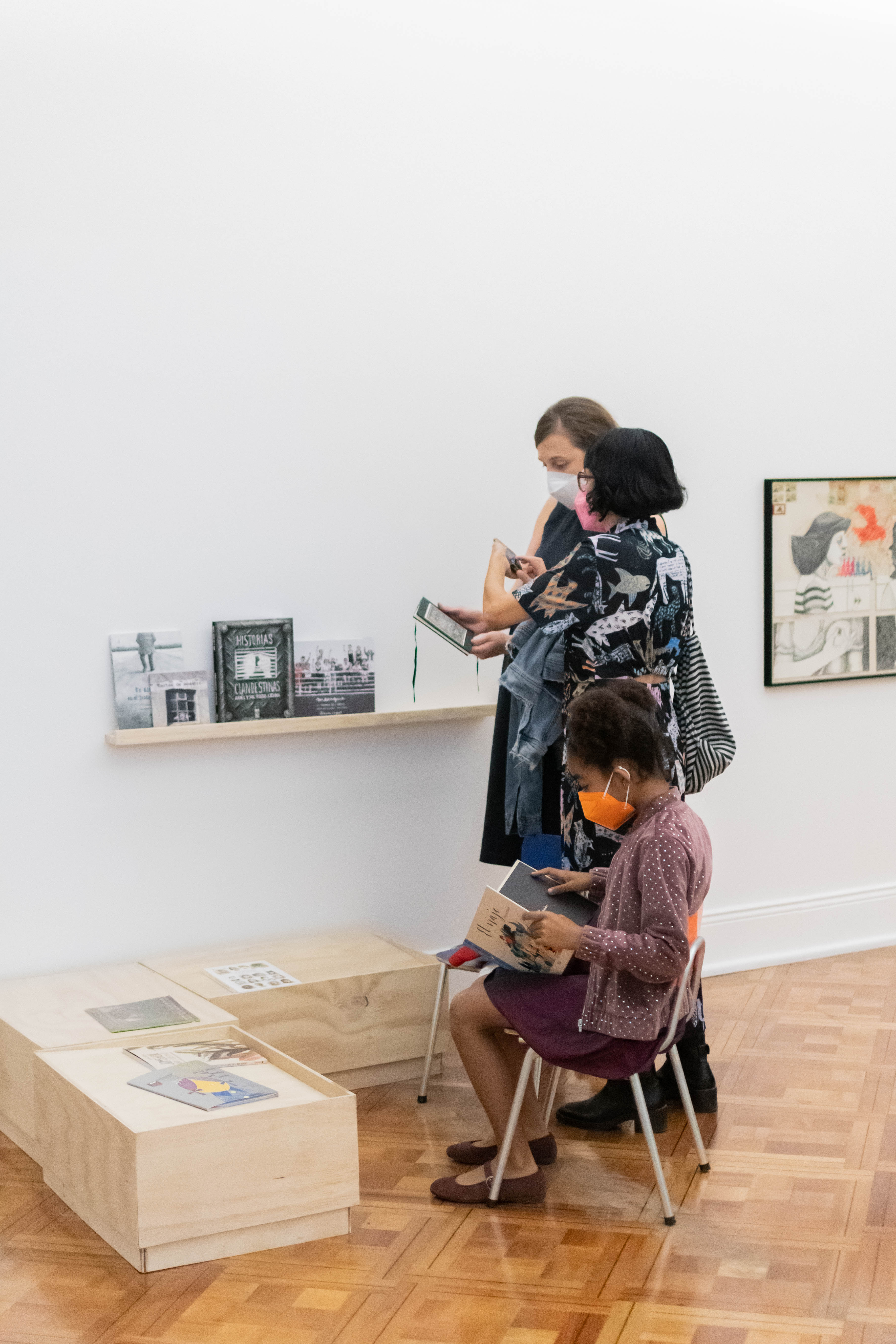
Visitors inhabiting ‘Exile’ section of the exhibition In the Jungle There Is Much to Do. Courtesy of MSSA. Photo: Lorna Remmele
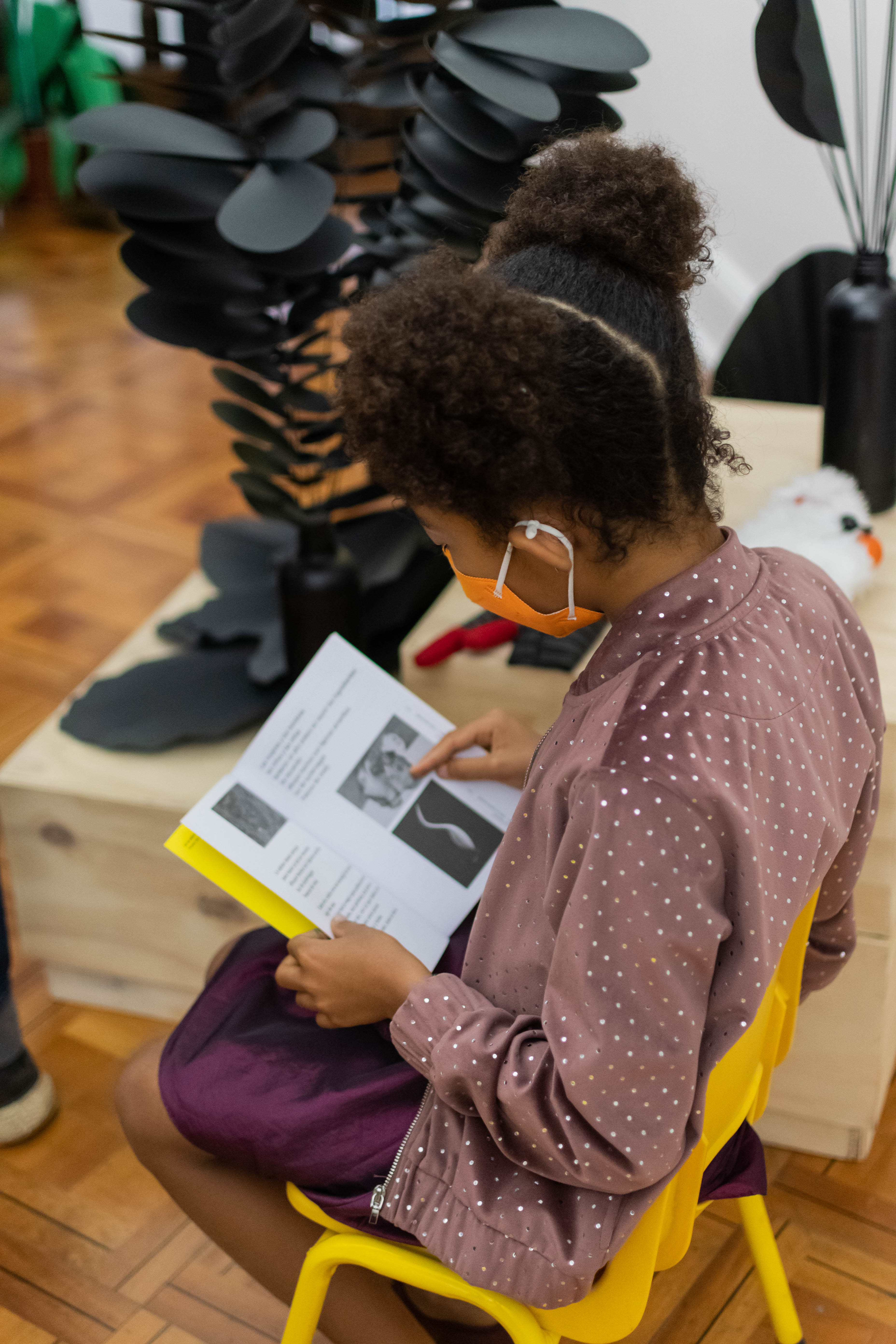
Visitor inhabiting ‘The Hunters’ section of the exhibition In the Jungle There Is Much to Do. Courtesy of MSSA. Photo: Lorna Remmele

Spread of Mauricio Gatti’s In the Jungle There Is Much to Do in ‘The Jungle’ section. Courtesy of MSSA. Photo: Lorna Remmele
From the beginning we looked at the collection with the entire staff of the museum. All the hanging was much lower than the standard white European male height, at wheelchair and children’s height. What I hadn’t thought of was that this hang height would also be much more suited to the women of the neighbourhood who kept coming back to visit the exhibition. The most outstanding comment I have ever received in my curatorial career came from these women when I asked them why they kept returning. They said they had come to the museum to do workshops in the past, but often found the exhibitions difficult to relate to. ‘In the Jungle There Is Much to Do’, they told me, was filled with their stories, so they returned because they felt it was for them and they felt at home. That was beautiful. We had the privilege of working with a wonderful exhibition designer, Pedro Silva, who together with his students created the jungle and truly engaged in the desire of creating a space of hospitality. They spent a semester making the paper plants with which they promenaded to the museum the day before the opening. For me it really showed what art can do when we commit to understanding museums as a space for collective learning.
FV: Thinking more about the tension you described, Maria, between the figure of the artist and the educator, and how they relate to power structures within the institution: sometimes it feels like education should take power, at the centre of the institution, yet that only reinforces hierarchical structures. Instead of taking power, fighting for power, transformative practice should aim to dissolve power structures altogether. Queer pedagogies are particularly helpful here – they stress the importance of not needing any hegemony, not wanting to place your voice at the centre.13 I’ve also been thinking about illustrated books and strategies that don’t rely on hegemonic tools. Rather than using speech and discourse, you use other strategies and methodologies to resolve tensions. In Marina Garcés’s publication Escuela de aprendices (The School of Apprentices),14 she talks about the idea of education as welcoming, reception, acogida – I don’t know how you translate this…
MB: Hospitality?
FV: Acogida is also how you read people, how you read the other. Garcés describes a set of practices and conditions in relation to the welcoming systems of each society.15 But education can and has been hierarchical and violent – not only in dictatorships but also in so-called democracies. In neoliberal contexts education institutions can be very violent for some individuals and collectives. So, a set of practices that generate ideas around what it means to welcome, to be hospitable, seems vital. These practices, in dialogue with queer pedagogies, might help to decentralize power structures in big institutions.16 This also helps to give communities more agency around their visibility. Opacity can be a useful tool for communities to not become vulnerable through hyper-visibility. It is not about making people or ideas invisible, but more about obscuring any centre for power to revolve around.
NA: So education not as an inherently good thing but as a set of practices that enable conditions for learning – whether around the scenography of an exhibition, or approaches to language and discourse. Those conditions are the education itself. For me, it’s a helpful distinction.
YH: Those conditions make up how welcome someone will feel. If we take the example of the security guard, they play a vital educational role. All of this back-of-house work, what feminist discourse names as ‘invisible labour’, can make the exhibition space less performative and more praxis-oriented. To do this, we need to bring everyone along, including security. They are the custodians of the exhibition as they host it, and how they interact with you changes if you feel welcome and able to move your body differently than how you normally would in a museum, or whatever normative shift is being proposed by an exhibition. If the aim is to invite those who don’t typically visit museums and to shift the logic of how you visit a museum, then the praxis must work through welcoming strategies, rather than necessarily what is being represented in the exhibition.
MB: The security guards, the front desk staff, are in a way the main educators in the institution. We have already touched on how care or reproductive labour is practiced in the museum, but it is also interesting how roles are turned upside down or reproduced when they step into the museum context. Children’s workshops, for example, involve complex dynamics between parents, children and teachers that can be difficult to navigate. Sometimes parents and teachers are the ones bringing in pre-prescribed roles and prejudices, and I say this as a mother. Children can be blocked from learning things and from each other because we, as parents or educators, overprescribe or demarcate exactly how and where learning should take place.
FV: We did a big project with SAVIA, an education project at Reina Sofía, working with La Parcería infancia y familia (Childhood and Family Partnership), a collective that thinks through alternative ways to take care of kids, and one of the main points of focus is the use of language.17 Institutions have strong opinions about the kind of language you are allowed to use. For example, some institutions use diminutive forms, pretending to be writing to children when in fact they are writing to parents, speaking to the child through the parent. I’m interested in changing or moving the direction of communication so that the institution is in a less stable position.
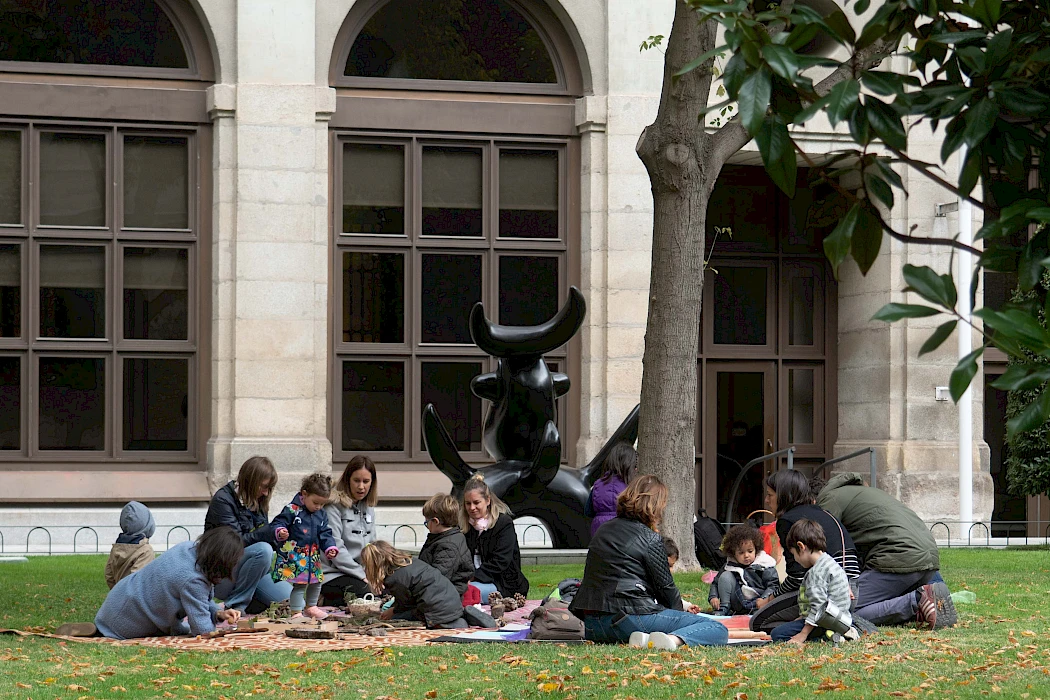
Savia, Museo Reina Sofía, 2019. Photos: Daniel Pompa Jordán

Savia, Museo Reina Sofía, 2019. Photos: Daniel Pompa Jordán
MB: Museum bookshops are very revealing. The children’s books you tend to find in museum bookshops are the most policing books. They reflect a very narrow, hierarchical and mainstream conception of education for children in the museum context. They are demeaning and sometimes violent – if we were to transform the books available for children in most museum bookshops to adult versions, if we were to transfer their notion of education to adult books, we would rightly be appalled. And this ideology is way more oppressive and conservative than any museum’s security guard.
FV: Each institution has its own violence. I worked in public schools as a teacher for many years. I saw how nationalism and racism were present there as a form of state violence. These things aren’t always explicit – often in schools, they are subtle. When I arrived at the museum I felt the power of the institution – its proximity to prestige, value and money, which creates other kinds of violence and hierarchies. The task is to address these institutional violences and generate practices that can work in the gaps of these structures.
The views and opinions published here mirror the principles of academic freedom and do not necessarily reflect the views or positions of the L'Internationale confederation and its members.
Related activities
The Open Kitchen. The fermented seed, colonialism and extractivism

The MACBA Kitchen is a working group situated against the backdrop of ecosocial crisis. Participants in the group aim to highlight the importance of intuitively imagining an ecofeminist kitchen, and take a particular interest in the wisdom of individuals, projects and experiences that work with dislocated knowledge in relation to food sovereignty.
The Kitchen: Workshop by Marina Monsonís

The Kitchen is a meeting place open to the participation of all, especially people and organizations that want to share their knowledge and experiences around the kitchen.
Multicultural Youth Center

The Museum of Modern Art in Warsaw, together with the confederation of museums L'Internationale, is establishing a Multicultural Youth Center. This is a unique space for 16-24 year olds to explore and develop their creativity, make new friends and hang out in a friendly and supportive environment.
Where are the Oases?

PEI OBERT seminar
with Kader Attia, Elvira Dyangani Ose, Max Jorge Hinderer Cruz, Emily Jacir, Achille Mbembe, Sarah Nuttall and Françoise Vergès
An oasis is the potential for life in an adverse environment.
Mobile Garden. A Place to Meet

An open space, a social space. How could the Museum be more open to the needs of the neighbourhood?
School of Commoning Practices
This exchange programme gathers different schools organized by volunteers and migrant communities in Athens (Open School for Migrants) and Madrid (School of Rights, Escuela de Español and Situated mediation School) in order to share their knowledge, exchange strategies and reflect on the experience of working together with migrant communities.
Team of Teams

This project researches citizen participation as a fundamental pillar in the creation of community.
Sustainable Art Production
The Studies Center of Museo Reina Sofía will publish an open call for 4 residencies of artistic practice for projects that address the emergencies and challenges derived from the climate crisis such as food sovereignty, architecture and sustainability, communal practices, diasporas and exiles or ecological and political sustainability, among others.
SUPERHOST | Club Antena. Intimate listening and dancing experience
with Nele Möller, Farida Amadou, Le Réalism, Céline Gillain, Roberta Miss, Elena Colombi
CLUB ANTENA is an intimate listening and dancing session with a lecture, concert, performance, catering and DJ sets, exploring what it means to listen with our bodies.
Red, Green, Black and White

A performative inquiry by Institute of Radical Imagination and MSU Zagreb
Tongue and Throat Memories

On hospitality and conviviality through food
Knowledges and convenings
Cooking Sessions
Related contributions
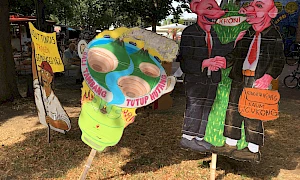
Lumbung practices to resist and collaborate through art

Some Guiding Terms for Lumbung Press: Defining “publishing”
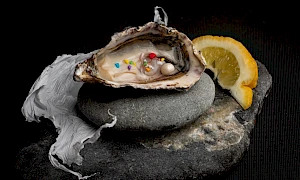
Discomfort at Dinner: The role of food work in challenging empire

Mix tape: Let's Funk Up All Genders!

Towards Collective Learning, or, Decompartmentalizing Education
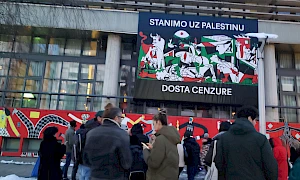
The Silence Has Been Unfolding For Too Long
